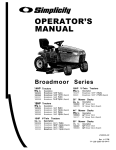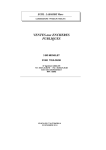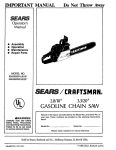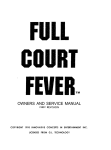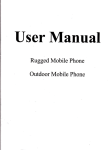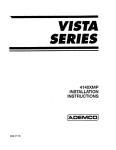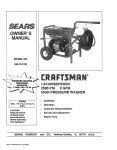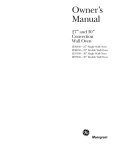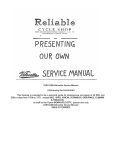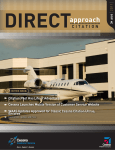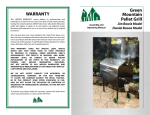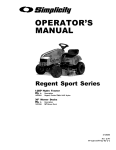Download Simplicity 1692521 Specifications
Transcript
OPERATOR’S M ANUAL SPECIAL EDITION REGENT “TEAM”TRACTORS Vikings Regent Tractor Badgers Regent Tractor Mfg. No. 1692957 Mfg. No. 1692967 Steelers Regent Tractor Hawkeyes Regent Tractor Mfg. No. 1692959 Mfg. No. 1692969 Panthers Regent Tractor Wolverines Regent Tractor Chiefs Regent Tractor Spartans Regent Tractor Mfg. No. 1692963 Mfg. No. 1692973 Colts Regent Tractor Nittany Lions Regent Tractor Mfg. No. 1692961 Mfg. No. 1692965 Mfg. No. 1692971 Mfg. No. 1692975 With 38” Mower Decks Mfg. No. 1692358 Trim Installation Face Mask installation: 1. Position the face mask onto the unit with the hook in the middle grille slot, and line up with the holes on the outside of the side panels (note that the front of the face mask must be in the “V” position for proper fit.) 2. Insert one Carriage Bolt through each of the two mounting holes at the rear of the face mask, and into the side panels. Hook from Face Mask goes into middle gri//e s/o’\ 3. Place one washer onto each Carriage Bolt from the inside of the panel. 4. Thread one Nut onto each Carriage Bolt. 5. Check that the Face Mask is in the proper position and orientation. 6. Tighten the Nuts securely. NOTE: “V” positioning -I\\- 1 Carriage Bolt b Decal 81 Paint Information Tractor Description Mfg. No. Base Color Accent Color Mask Color Vikings Regent Tractor 1692957 Viking Purple Viking White Viking Purple Steelers Regent Tractor 1692959 Gloss Black Steelers Yellow Black Panthers Regent Tractor 1692961 Panthers Silver Pro Blue Black Chiefs Regent Tractor 1692963 Chiefs Red Chiefs White Chiefs White Colts Regent Tractor 1692965 Colts White Colts Blue Colts Blue Badgers Regent Tractor 1692967 Badger White Badger Red Badger Red Hawkeyes Regent Tractor 1692969 Gloss Black Hawkeye Yellow Gloss Black Wolverines Regent Tractor 1692971 Wolverine Blue Wolverine Yellow Wolverine Blue Spartans Regent Tractor 1692973 Spartan Green Spartan White Spartan White Nittany Lions Regent Tractor 1692975 Lions Blue Lions White Lions Blue NOTE ON PAINT COLORS: Standardized paint coding schemes are not given because the paint colors used on your Special Edition Regent “Team” Tractor were matched directly (via a sophisticated color analysis system) to the exact colors on team helmets. If it becomes necessary to repaint a scratched or damaged portion of your unit, your local paint service will need to do a similar color analysis from a clean portion of a body panel or hood. NOTE ON DECALS: For a limited time, replacement decal sets may be ordered from your local Simplicity dealer. FormNo. FIB". 3/w 0 Copylight ,996 simplici~ Man"f?.ti"ring, Inc. AU Rights msened. Printed I" USA. TP LOO-20L3-03-RG-S (SM) Table Of Contents TRACTOR & MOWER IDENTIFICATION.. .................. .2 TROUBLESHOOTING & REPAIR.. ............................ .18 General.. ............................................................................ .I8 SAFETY RULES ............................................................3 DECALS.. ...................................................................... .5 FEATURES & CONTROLS ........................................... Controls - Hydro Models.. .................................................... Controls - Gear Models.. ....................................................... 6 .6 6 19 Rights .20 .Q .Q .Q 9 .lO .10 Brake Adjustment ............................................................. Neutral Adjustment - Hydro ............................................... .21 ,22 Forward Speed Adjustment - Hydro .................................. .22 Neutral Adjustment - Gear.. ............................................... .23 Steering Gear Adjustment ................................................. .23 .23 Mower Adjustments ........................................................... Leveling The Mower........................................................ Blade Brake Check ........................................................... .23 24 BELT REPLACEMENT.. ............................................. .25 Tractor Drive Belt .................................................. .25 Mower Deck Belt.. ................................................. .25 SPECIFICATIONS.. ..................................................... .26 PARTS & ACCESSORIES.. ........................................ .27 Replacement Pads ............................................................ .27 .15 15 16 Maintenance Items ............................................................ .27 Optional Accessories.. ....................................................... .27 Technical Literature ........................................................... .27 INTERNATIONAL SYMBOLS.. .................................... 28 NOTE: In this manual, “/eW and “right” are referred to as seen from the operating position. .I7 Engine exhaust from this product contains chemi- :..‘:. ....................... .I7 birth defects, or other reproductive harm. 0 1996 Simplicity Mfg, Inc. All TP L00-20L3-03-RG-SnA .l 9 ADJUSTMENTS ........................................................... 21 Seat Adjustment ................................................................ ,21 STORAGE .................................................................. .I7 Temporary Storage.. .......................................................... .17 Long T e n Storage.. .......................................................... Checking the Battery .......................................................... Auxiliary (Booster) Battery.. ............................................ NORMAL CARE ......................................................... .13 Schedule.. .......................................................................... .13 .I3 Raising the Hood & Seat .................................................. Checking/Adding Gasoline ................................................ .I3 Checking Tire Pressure.. ................................................... .14 .I4 Checking the Fuel Filter.. ................................................... Lubrication ......................................................................... .14 .I5 Transaxle - Hydro Models.. ................................................ Battery Maintenance.. ........................................................ .I5 Starting After Storage.. ........................ .lQ Discharged Battery.. ....................................................... Jump Starting with MOWING PATTERN & TIPS ....................................... 11 Checking Battery Fluid.. .................................................. Cleaning the Battery and Cables.. ................................... Servicing the Mower Blades.. ............................................. .18 Troubleshooting The Mower.. ............................................ Charging A Completely OPERATION.. ............................................................... .7 General.. ..................... . ........................................................ .7 Safety Interlock System.. ...................................................... 7 Mower Installation & Removal.. .......................................... .8 .8 Adjusting Mower Height ...................................................... Q Checks Before Starting ........................................................ Clutch/Brake Pedal - Gear Models.. .................................... Parking Brake.. .................................................................... Starting The Engine.. ........................................................... Driving The Tractor ............................................................... Stopping the Tractor.. ........................................................ Pushing the Tractor by Hand ............................................ Troubleshooting The Tractor ............................................. Reserved. Printed in USA. 1 Tractor & Mower Identification IDENTIFICATION NUMBERS Record your model name/number, tractor and mower deck manufacturer numbers and engine serial number in the space provided for easy reference. l l l Tractor M/N (Manufactureh Number) SIN (Serial Number) The Tractor I.D. tag is located on the left-side, of the frame, as shown below. Mower Deck M/N (Man”m”rels N”nlW S/N (Serial Number) The Mower Deck I.D. tag is also on the left side, on top of the mower deck. Dealer Name oaw Purchased For location of Engine Serial Number, refer to the Engine Owner’s Manual. il~~~~~~~~~~~~~~~~~~~~~~~~~~~~~ Be sure to fill out and return the Warranty Registration Card supplied with your tractor. Engine Make/Model Engine Iwserial Number r Tractor Identification Ta . ..-..-. -““.. Identification Tag - Figure 1. Identification Tags Location 03 2 Safety Rules A Read these safety rules and follow them closely. Failure to obey these rules could result in loss of control of unit, severe personal injury or death to you, or bystanders, or damage to property or equipment. This mowina deck is caDable of amoutatina hands and feet and throwina obiects. The triangle a in text signifies important cautions or warnings which must be followed. GENERAL OPERATION l l l l l l l A WARNING - SLOPE OPERATION Never operate on slopes greater than 30 percent (16.7”) which is a rise of three feet vertically in 10 feet horizontally. When operating on slopes that are greater than 15 percent (6.5”) but less than 30 percent use front counterweights and rear wheel weights (see your dealer). Select slow ground speed before driving onto slope. In addition to front and rear weights, use extra caution when operating on slopes with rearmounted orass catcher. Mow UP and DOWN the slooe. never a&ss the face, use caution when changing directions and DO NOT START OR STOP ON SLOPE. Read, understand, and follow all instructions in the manual and on the unit before starting. Only allow responsible adults, who are familiar with the instructions, to operate the unit. Clear the area of objects such as rocks, toys, wire, etc., which could be picked up and thrown by the blade(s). Be sure the area is clear of other people before mowing. Stop unit if anyone enters the area. Do Never carty passengers. l Do not mow in reverse unless absolutely necessary. Always look down and behind before and while travelling in reverse. Be aware of the mower discharge direction and do not point it at anyone. Do not operate the mower without either the entire grass catcher or the deflector in place. l Mow up and down slopes, not across. l Remove obstacles such as rocks, tree limbs, etc. l l l l Slow down before turning. Never leave a running unit unattended. Always disengage the PTO, set parking brake, stop engine, and remove keys before dismounting. l l l l l l l l Turn off the PTO switch to disengage the blades when not mowing. Watch for holes, ruts, or bumps. Uneven terrain could overturn the unit. Tall grass can hide obstacles. Use slow speed. Choose a low gear so that you will not have to stop or shift while on the slope. Use extra care with grass catchers or other attachments. These can change the stability of the unit. Keep all movement on the slopes slow and gradual. Do not make sudden changes in speed or direction. Do Not Stop engine before removing grass catcher or unclogging chute. l Mow only in daylight or good artificial light. Do not operate the unit while under the influence of alcohol or drugs. l Watch for traffic when operating near or crossing roadways. l Use extra care when loading or unloading the unit into a trailer or truck. SLOPE OPERATION See your authorized dealer for recommendations of wheel weights or counterweights to improve stability. ,. l Slopes are a major factor related to loss-of-con&l and tip-over accidents, which can result in severe injury or death. All slopes require extra caution. If you cannot back up the slope or if you feel uneasy on it, do not mow it. l l 3 Do notstart or stop on a slope. If tires lose traction, disengage the blade(s) and proceed slowly straight down the slope. Do notturn on slopes unless necessary, and then, turn slowly and gradually downhill, if possible. Do not mow near drop-offs, ditches, or embankments. The mower could suddenly turn over if a wheel is over the edge of a cliff or ditch, or if an edge caves in. Do not mow on wet grass.-Redmed traction could cause sliding. Do nottty to stabilize the unit by putting your foot on the ground. Do not use grass catcher on steep slopes. Safety Rules CHILDREN b) Never remove gas cap or add fuel with the engine running. Allow engine to cool before refueling. Do not smoke. Tragic accidents can occur if the operator is not alert to the presence of children. Children are often attracted to the unit and the mowing activity. Never assume that children will remain where you last saw them. l l l l l l c) Never refuel the unit indoors. l Keep children out of the mowing area and under the watchful care of another responsible adult. l Be alert and turn unit off if children enter the area. l Before and during reverse operation, look behind and down for small children. l Never carry children. They may fall off and be seriously injured or interfere with safe unit operation. l Never allow children to operate the unit. l Use extra care when approaching blind corners, shrubs, trees, or other objects that may obscure vision. TRANSPORTING AND STORAGE l A WARNING When transporting this tractor on an open trailer, make sure unit is facing forward, toward the direction of travel. If tractor is facing backward, wind lift could cause damage to the hood. l l l l l Always observe safe refueling and fuel handling practices when refueling the tractor after transportation or storage. l Always follow the engine manual instructions for storage preparations before storing the tractor for both short and long term periods. l l Always follow the engine manual instructions for proper start-up procedures when returning the unit to service. l Never store the unit or fuel container inside where there is an open flame or pilot light, such as in a water heater. Allow unit to cool before storing. l SERVICE AND MAINTENANCE l Never run a unit in an enclosed area. Keep nuts and bolts, especially blade attachment bolts, tight and keep equipment in good condition. Never tamper with safety devices. Check their proper operation regularly. Keep unit free of grass, leaves, or other debris buildup. Clean up oil or fuel spillage. Stop and inspect the equipment if you strike an object. Repair, if necessary, before restarting. Never make adjustments or repairs with the engine running unless specified otherwise in the engine manufacturer’s manual. Grass catcher components are subject to wear, damage, and deterioration, which could expose moving parts or allow objects to be thrown. Frequently check components and replace with manufacturer’s recommended pans, when necessary. Mower blades are sharp and can cut. Wrap the blade(s) or wear gloves, and use extra caution when servicing them. Check brake operation frequently. Adjust and service as required. Use only factory authorized replacement parts when making repairs. Always comply with factory specifications on all settings and adjustments. Only authorized service locations should be utilized for major service and repair requirements. Never attempt to make major repairs on this unit unless you have been properly trained. Improper service procedures can result in hazardous operation, equipment damage and voiding of manufacturers warranty. Use extra care in handling gasoline and other fuels. They are flammable and vapors are explosive. Never place hands near the hydro-pump cooling fan when the tractor is running. Cooling fan is located on top of transaxle on hydro models. a) Use only an approved container. A Safety Decals GENERAL All WARNING, CAUTION and instructional messages on your tractor and mower should be carefully read and obeyed. Personal bodily injury can result when these instructions are not followed. The information is for your safety and it is important! The safety decals below are on your tractor and mower. This unit has been designed and manufactured to provide you with the safety and reliability you would expect from an industry leader in outdoor power equipment manufacturing. Although reading this manual and the safety instructions it contains will provide you with the necessary basic knowledge to operate this equipment safely and effectively, we have placed several safety labels on the unit to remind you of this important information while you are operating your tractor. If any of these decals are lost or damaged, replace them at once. See your local dealer for replacements. These labels are easily applied and will act as a constant visual reminder to you, and others who may use the equipment, to follow the safety instructions necessary for safe, effective operation. Decal - Danger Part No. 1704276 (top decal) Part No. 1704277 (bottom decal) Decal - Hydro Release Valve Part No. 1706916 ‘, Decal - Operating Instructions Part No. 1716530 03 5 Features & Controls CONTROLS - HYDRO MODEL 4. 3. :. I. 3. r. 3. i. Steering Wheel Engine Throttle Control Parking Brake Knob Ignition Key/Switch Headlight Switch PTO (Electric Clutch) Switch Mower Height Adjustment Lever Brake Pedal I. Forward Direction Pedal I. Rear Direction Pedal Figure 2. Tractor & Mower Controls - Hydra Model CONTROLS - GEAR MODEL A. B. C. D. E. F. G. H. I. Steering Wheel Engine Throttle Control Parking Brake Knob Ignition Key/Switch Headlight Switch PTO (Electric Clutch) Switch Mower Height Adjustment Lever Clutch/Brake Pedal Gear Selector Figure 3. Tractor & Mower Controls - Gear Model 6 Operation GENERAL SAFETY INTERLOCK SYSTEM Before first time operation, drive in an open area without mowing, to become accustomed to the unit. Be sure to read all information in the Safety and Operation sections before attempting to operate this tractor and mower. Your tractor is equipped with a seat switch safety systern. Check the seat switch operation every fall and spring with the following three tests. A WARNING - SLOPE OPERATION Never operate on slopes greater than 30 percent (16.7”) which is a rise of three feet vertically in 10 feet horizontally. When operating on slopes that are greater than 16 percent (6.5”) but less than 30 percent use front counterweights and rear wheel weights (see your dealer). Select slow ground speed before driving onto slope. In addition to front and rear weights, use extra caution when operating on slopes with rearmounted grass catcher. Mow UP and DOWN the slops, never across the face, use caution when changing directions and DO NOT START OR STOP ON SLOPE. I A WARNING Never allow passengers to ride on the unit. Test 1 - Engine should NOT crank if any of the following conditions exist: l Transmission is out of neutral. l PTO switch is engaged. l Test 2 - Engine should crank if ALL of the following conditions are met: l Transmission is in neutral. l PTO switch is disengaged. l Clutch/brake pedal is fully depressed. Test 3 - Engine should shut off if any of the following conditions exist: l A WARNING Towing the tractor will cause transmission damage. Do not use another vehicle to push or pull tractor. l l AWARNING To reduce fire hazard, keep the engine and mower free of grass, leaves and excess arease. Clutch/brake pedal is not fully depressed. Operator rises off seat with transmission in gear and the clutch/brake pedal not fully depressed, and/or the oarkina brake is not set. ’ Operator rises off seat with clutch/brake pedal not depressed; Operator rises off seat with PTO engaged. NOTE: Once the engine has stopped, the PTO switch (F, figures 2 & 3) must be turned off after operator returns to the seat in order to start the engine. Operation II I. I / Figure 4. Mower Deck - Right Side A. Clip C. Height Adjustment Lever B. Pin 84 Clip Figure 5. Mower Deck - Left Side A. Rod 6. Pin & Clip C. Lever MOWER INSTALLATION & REMOVAL A WARNING Engage parking brake, disengage PTO, stop engine and remove key before attempting to install or remove the mower. NOTE: Perform mower removal and installation on a hard, level surface such as a concrete floor. 1. Turn the front wheels of the tractor full left. 2. Place the mower in lowest cutting position. 3. Remove clip (A, figure 4) from right side of rod. Pull rod (A, figure 5) out from left side. 4. Move lever (C, figure 5) towards the right side of tractor to release belt tension, then slide belt off of PTO pulley. Figure 6. Front Hitch A. Release Rod 6. Hitch 5. Disconnect the front hitch by pulling out on the release rod (A, figure 6) and lifting the mower hitch off the tractor hitch. Slide the mower deck out from under the right side of the tractor. 6. Install the mower in the reverse order. NOTE: When installing rod (A, figure 5), turning the front wheels slight/y left or right helps to align the holes. ADJUSTING MOWER CUlTlNG HEIGHT NOTE: Perform adjustment on a hard, leve,l.surface as a concrete floor. such 1. Set the mower height adjustment lever (A, figure &) to the desired cutting height. 2. Remove the pin &clip (B, figures 7) from each mower deck front gauge wheel. 3/4”- 1”with Height Adjuster Lever in lower 3 slots -I 2” with Height Adjuster Lever in upper 3 slots 3. Adjust the gauge wheels to achieve the appropriate mower deck-to-ground clearance, as shown in figure 7. Reinstall pin & clip to each wheel. Figure 7. Adjusting Mower Deck Gauge Wheels A. Mower Height Adjustment Lever B. Pin & Clip 6 Operation CHECKS BEFORE STARTING 1. Make sure you have proper wheel or counterweights installed if required. See Slope Operation in the Safety Rules section. Make sure any slopes are within required limits. 2. Check that crankcase is filled to full mark on dipstick. See the engine Operator’s Manual for instructions and oil recommendations. 3. Make sure all nuts, bolts, screws and pins are in place and tight. 4. Make sure you can reach all controls from operator’s positions. If not, see SEAT ADJUSTMENT. 5. Fill the gasoline tank with fresh gasoline. Fill to bottom of filler neck to avoid spillage and overflow. DO NOT mix oil with gasoline. Refer to engine manual for gasoline recommendations. Figure 8. Clutch/Brake Pedal Operation A. Clutch/Brake Pedal - Gear Model Brake Pedal - Hydro Model B. Parking Brake Knob A WARNING Gasoline is highly flammable and must be handled with care. Never fill the tank when the engine is still hot from recent operation. Do not allow open flame, smoking or matches in the area. Avoid overfilling and wipe up any spills. 6. Move the engine throttle control (B, figures 2 & 3) to SLOW. Warm up the engine by running it for at least a minute before engaging the PTO switch or driving the tractor CLUTCH/BRAKE PEDAL OPERATION DRIVING THE TRACTOR On gear model, depressing the pedal (A, figure 8) halfway disengages the transmission drive. Depressing pedal further applies the tractor brake. On hydro model, depressing the pedal applies the tractor brake. On hydro model, ground speed is infinitely variable according to how far the pedals (I & J, figure 2) are moved in the forward or reverse position. PARKING BRAKE Parking brake can be applied by fully depressing the brake pedal (A, figures 8) then pulling up on the parking brake knob (B, figure 8). On gear model, ground speed is selected by fully depressing the clutch/brake pedal, then moving the gear selector (I, figure 3) to the appropriate position. Most mowing is done in 3rd or 4th gear with engine speed between 3/4 and full speed. If the terrain is rough, hilly or sloping, use first or second gear. If the grass is wet or over three inches (76mm) high, use full engine speed (with low gear) so the mower will have enough power to cut the grass. Shift gears onlywith Tractor stopped and clutch/brake pedal fully depressed. STARTING THE ENGINE 1. While sitting in the operator seat, set the parking brake. 2. Set engine throttle control (6, figures 2 & 3) all the way up to CHOKE. A warm engine may not require ‘. choking. 3. Disengage the PTO by pushing the s\h;itc,h all the way down (F, figures 2 & 3) 1. If you are ready to mow, set the mower to the desired cutting height. See Adjusting Mower Cutting Height, page 8. 4. On hydro models, with your foot off the pedals (I & J, figure 2) the tractor is in the neutral position. On gear models, put the gear selector (I, figure 3) in neutral. 2. Set engine throttle control (B, figures 2 & 3) for desired speed. Between 3/4 and full speed is recommended for mowing. 5. Insert the key into the ignition switch (D, figure 2 & 3) and turn it to START. 3. Engage the mower PTO by pulling up on the switch (F, figures 2 & 3). 9 Operation PUSHING THE TRACTOR-BY HAND 4. On hydro model, release the parking brake by depressing the brake pedal (A, figure Et), then press down on either pedal (I or J, figure 2) for the desired direction and speed of travel. On gear model, fully depress clutch/brake pedal (A, figure 8) to release the parking brake and disengage the clutch. Use the gear selector (I, figure 3) to select the gear best suited for conditions, then slowly release clutch/brake pedal to engage clutch and start tractor in motion. Hydro Model 1. With engine off and key removed, disengage the PTO by pushing the switch (F, figures 2 8 3) all the way down. STOPPING THE TRACTOR 2. See figure 9. The release lever is located under the rear tractor frame, above the transmission. Release lever must be in the rearward position to push the tractor by hand. 1. On hydro model, gradually take your foot off the pedals (I & J, figure 2) to make a smooth stop. To make a more rapid stop, depress the brake pedal (H, figure 2). On gear model, press the clutch/brake pedal (A, figure 8) down only far enough to disengage the clutch to make a gradual stop. For a more rapid stop, press pedal down fully to apply the brake. To drive the tractor, release lever must be moved completely forward to engage the DRIVE position. Gear Model 2. Engage the parking brake by pulling up on the knob (B, figure 8) with the brake pedal fully depressed. 1. With engine off and key removed, disengage the PTO by pushing the switch (F, figures 2 & 3) all the way down. 3. Disengage the PTO by pushing down on the switch (F, figures 2 & 3). 4. Set engine throttle control to SLOW. Stopping a hot engine too fast may cause engine damage. Let engine idle for about a minute. 2. Place the gear selector in the NEUTRAL position. 3. Unlock parking brake. I II , 5.Turn key to OFF and remove it. Before leaving the operator’s position for any reason, engage the parking brake, disengage the PTO, stop the engine and remove the key. A WARNING To reduce fire hazard, keep the engine, tractor and mower free of grass, leaves and excess grease. Do not stop or park tractor over dry leaves, grass or combustible materials. Figure 9. Release Lever - Hydro Models ‘. 10 1 Mowing Patterns & lips GENERAL l For the first use of the mower, choose a smooth level area. Cut long straight strips overlapping slightly. The size and type of area to be mowed determines the best mowing pattern to use. Obstructions such as trees, fences and buildings must also be considered. Where possible, make one or two passes in a counterclockwise direction around the outside of the area to keep the cut grass off fences and walks. The remainder of the mowing should be done in a clockwise direction so the clippings are dispersed on the cut area. Keep in mind the following lawn care and mowing tips: l Too much maintenance is as detrimental to your lawn as neglect. l Mow when grass is 3-5 inches tall. Don’t cut shorter than 2 to 2-i/2 inches. Cut only the top one-third of the grass blade. Cutting below this level can lead to thatch problems. Your mower has a cutting height adjustment that can help you maintain a proper length. l For extremely tall grass, set the cutting height at maximum for the first pass, and then reset to the desired height and mow again. clippings of an inch or less decoml Mow often. Short pose more quickly than longer blades. l Keep the blades on your mower sharp for finer clippings. l Let grass grow a bit longer when it is hot to reduce heat build-up and protect grass from heat damage. l Use slow-release fertilizer for slow, even growth. l l l l l l b. Adjust deck flat to l/8” maximum lower in front. c. Use 3/4 engine speed. d. Clean deck of built-up material/caked-on grass. MULCHING MOWER OPERATION (OPTIONAL KIT ATTACHMENT) Mulching Mulching consists of actually cutting and recutting clip pings into tiny particles and blowing them into the lawn. These tiny particles decompose rapidly into by-products your lawn can use. Under proper conditions, your mulching mower will virtually eliminate noticeable clippings on the lawn surface. Keep in mind these mulching tips: l Use mulching mower or muicher kit without shredders for grass mulching. Don’t cover grass surface with a heavy layer of clippings. Consider using a grass collection system and starting a compost pile. Aerate lawn in spring, consider renting an aerator which removes cores of soil from the lawn. This increases the speed of clipping decomposition and deep root growth by opening up the soil and permitting greater movement of water, fertilizer and air. Don’t over-water. Too much water can encourage disease development. Mow when the grass is dry, preferably in the late afternoon when the temperatures are cooler. Where possible, change patterns occasionally to eliminate matting, graining or a corrugated appearance. For wet grasses, grasses prone to wheel tracking and for collecting clippings: a. Use sharp blades. l Install shredders for leaf shredding. l Use maximum engine speed. l Raise height of cut if excessive power is used. l l Must use sharp blades. Do not use lift tabs or high lift blade when mulching. Adjust to lower ground speeds in heavy grass or if wind rowing is present. l Clean deck of built-up material/caked-on grass. l Check for free movement of mower idler pulley. Mowing Conditions The best mulching results from mowing when lawn is dry and grass blades are not ovec5’:long. Follow these guidelines for best results: l b. Adjust deck l/4” higher in front than in rear. c. Run at maximum engine speed. For dry conditions where grass blow-out is a problem: a. Use sharp blades. speed but slow ground l d. Clean deck of built-up material/caked-on grass. e. Check for free movement of mower idler pulley. 11 Do not use the mower as a mulching mower during the first two or three mowings in the spring. The long grass blades, quick growth, and often wetter conditions are more suitable for side-discharge (broadcasting) or grass bagging operation. Avoid mulching after rain or heavy dew. It may be better to mow later in the day or early evening when lawn is drier. Mowing Patterns & lips l l Change the mowing pattern each time. The Best Combination If mulching baffles are removed, the original deflector must be in operating position for safe side-discharge mowing. We recommend that you experiment with the height of cut position and tractor ground speed that will give you the best cut. Start with a higher cutting height and try increasing lower settings until you find a cutting height that is matched to your mowing conditions and preferences. Since mulching requires more horsepower than side-discharging, using a slower ground speed is important for proper mulching operation. How Much Grass To Cut Off Removing too much grass height in one cutting may result in an unsatisfactory cut: wind rowing, clumping, or uneven dispersal of clippings may result. It is best to mow when the grass is between 3”- 5” tall, although this will depend on your personal preference for lawn appearance. A good rule to follow is to cut only the top onethird of the grass blade at a time (maximum of l-1/2”). Cutting more off the grass blade, particularly in wet spring conditions, can lead to thatch problems. Clippings Are Beneficial A common misconception about clippings is that they automatically lead to thatch. However, clippings produced by mulching methods actually contribute to a healthy lawn because they: l Optimal cutting point This area can contribute to thatch Act as a safe, non-polluting and inexpensive fertilizer that nourishes your lawn. Fresh cut blades are a rich source of nitrogen which is essential to lush growth. And one garbage bag of clippings contains about l/4 lb. of usable organic nitrogen. l Reduce the evaporation of water from your lawn. l Provide a cushioning layer to reduce lawn wear. l Moderate soil temperature. l Save money normally spent on trash bags. Leaf Shredding (For use with Mulcher Kit Only) Engine Speed & Ground Speed Patented Shredder Blades virtually eliminate raking leaves. Up to 512 cutting edges pulverize leaves into tiny particles, which quickly and naturally decompose into 1 food for your lawn. Shredder Blades must be removed when you choose to mulch grass clippings, Use full engine throttle matched with a slower ground speed so that clippings will be finely cut. A better cut may result from cutting the same area in two passes, each time cutting only 3/4” of grass blade. Short clippings of 1” or less decompose more quickly than longer blades. NOTE: When mulching under heavy cutting conditions, a rumbling sound may be present and is normal. The Proper Equipment Always keep the mower blades sharp and balanced. Blades should be sharpened at the beginning of every mowing season. If the tips of grass blades brown after cutting, this may be a sign of dull blades tearing, rather than cutting, the grass blades. Keep the underside of the mower deck and baffles clean so that clippings are properly circulated, chopped, and discharged back into the lawn. 12 Normal Care SCHEDULE The following schedule should be followed for normal care of your tractor and mower. You will need to keep a record of your operating time. Determining operating time is easily accomplished by multiplying the time it takes to do one job by the number of times you’ve done the job, or you can install the optional hour meter. * See the engine manufacturer’s owner’s manual. * * Change original engine oil after first 5 hours of operation. *** More often in hot (over 55’ F: 30” C) weather or dusty operating conditions. *** * Transaxle is a sealed unit and requires no regular interval fluid changes. RAISING THE HOOD & SEAT , Hood recess 1. To raise the hood, grasp the hood recess (figure 10) on top, then pivot the hood up and forward. 2. To raise the seat for battery access, tilt seat forward. CHECKING/ADDING GASOLINE Do not run the engine with the hood raised Engine heat will cause damage to the headlight A CAUTION Never use gasoline containing METHANOL, gasohol containing more than 10% ethanol, gasoline additives, premium gasoline, or white gas because enginelfuel system damage could result.Raise the hood and check the fuel tank to be sure there is enough gasoline to complete the job. To add gasoline, remove the gas cap. Do not overfill. Leave room in the tank for fuel expansion. Refer to your engine manual for gasoline recommendations. Install and hand tighten the gas cap. _. Figure 10. Gas Tank Located Under Hood 13 NormalCare CHECKING TIRE PRESSURE Front tire pressure should be 12 - 15 psi (82 - 103 kPa). Rear tire pressure should be 10 - 12 psi (56 - 82 kPa). CHECKING FUEL FILTER The fuel filter is located in fuel line between fuel tank and carburetor. If filter is dirty or clogged, replace as follows. Place a container below filter to catch spilled gasoline. A WARNING Do not remove fuel filter when engine is hot, as spilled gasoline may ignite. DO NOT spread hose clamps further than necessary. Ensure clamps grip hoses firmly over filter after installation. 1. Using a pliers, open and slide hose clamps from fuel filter. 2. Remove hoses from filter. 3. Install new filter in proper flow direction in fuel line. Secure with hose clamps. See warning at beginning of procedure. LUBRICATION Lubricate the tractor as shown in figures 11 & 12. When a grease gun is shown, wipe the fitting clean, apply two or three shots of lithium base automotive grease (Simplicity part no. 103077), and wipe off excess grease. When an oil can is shown, wipe the area clean, apply a few drops of oil (SAE 30), then wipe up drips or spills. IFigure 11. Lubricating Tractor ‘. Figure 12. Lubricating Mower Deck 14 Normal Care TRANSAXLE - HYDRO MODELS The hydro transaxle is a sealed unit. The transaxle is filled with oil and does not require any further lubrication unless a service overhaul is performed BATTERY MAINTENANCE Checking the Battery Fluid 1. Raise the seat by tilting it forward to gain access to the battery. A WARNING Be careful when handling the battery. Avoid spilling electrolyte. Keep flames and sparks awav from the batterv. Figure 13. Battery A. Positive Battery Terminal C. Battery Cap B. Negative Battery Terminal D. Battery Clamp 2. Remove battery filler cap (C, figure 13). Fluid must be even with split ring full mark. If not, add distilled water. 3. Reinstall filler cap. 2. Remove the battety clamp (D, figure 13) then remove the battey. Cleaning the Battery and Cables 3. Scrub the battey, cables and battery compartment with baking soda and water. 4. Clean the battery terminals and cable clamps with a wire brush and battery post terminal cleaner. 5. Reinstall battery and clamp. 6. Connect cables, positive cable first. Position positive cable over seat switch harness to orevent harness from becoming pinched in seat pivot. 1. Disconnect the cables from the battery, negative cable first (B, figure 13). 7. Coat cable clamps and terminals with grease or petroleum jelly. 15 NormalCare SERVICING THE MOWER BLADES A WARNING For your personal safety, do not handle the sharp mower blades with bare hands. Careless or improper handling of blades may result in serious injury. 1. Remove mower from the tractor. Sea Mower Installation & Removal. 2. Blades should be sharp and free of nicks and dents. If not, sharpen blades as described in following steps. 3. To remove blade for sharpening, use wooden block to hold blade while removing the blade mounting capscrew (figure 14). 4. Use a file to sharpen blade to fine edge. Remove all nicks and dents in blade edge. If blade is severely damaged, it should be replaced. Figure 14. Removing the Blade 5. Balance the blade as shown in figure 15. Center the blades’ hole on a nail lubricated with a drop of oil. A balanced blade will remain level. -Workbench 6. Reinstall each blade with the tabs pointing up toward deck as shown in figure 16. Secure with a capscrew, spring washer and hex washer. Use a wooden block to prevent blade rotation and torque capscrews to 5070 ftlbs. (67-95 N.m.). A WARNING For your personal safety, blade mounting capscrews must each be installed with a hex washer and spring washer, then securely tightened. Torque blade mounting capscrew to 50 - 70 ft. Ibs. (67 - 95 N.m.) Figure 15. Balancing The Blade Figure 16. Installing The Blade 16 Storage A WARNING Never store the tractor, with gasoline in engine or fuel tank, in a heated shelter or in enclosed, poorly ventilated enclosures. Gasoline fumes may reach an open flame, spark or pilot light (such as a furnace, water heater, clothes dryer, etc.) and cause an explosion. Handle gasoline carefully. It is highly flammable and careless use could result in serious fire damage to your person or property. Drain fuel into an approved container outdoors away from ooen flame or SDSrkS. or other waterproof material to keep out moisture, dirt and insects. TEMPORARY STORAGE (30 DAYS OR LESS) 7. Completely grease and oil tractor as outlined in the Normal Care section. Remember, the fuel tank will still contain some gasoline, so never store the tractor indoors or in any other area where fuel vapor could travel to any ignition source. Fuel vapor is also toxic if inhaled, so never store the tractor in any structure used for human or animal habitation. 8. Clean up tractor and apply paint or rust preventative to any areas where paint is chipped or damaged. 9. Be sure the battery is filled to the proper level with water and is fully charged. Battery life will be increased if it is removed, put in a cool, dry place and fully charged about once a month. If battery is left in tractor, disconnect the negative cable. Here is a checklist of things to do when storing your tractor temporarily or in between uses: l l l Keep the tractor in an area away from where children may come into contact with it. If there’s any chance of unauthorized use, remove the spark plug (s) and put in a safe place. Be sure the Spark plug opening is protected from foreign objects with a suitable cover. 10. Drain fuel system completely or add a gasoline stabilizer to the fuel system. If you have chosen to use a fuel stabilizer and have not drained the fuel system, follow all safety instructions and storage precautions in this manual to prevent the possibility of fire from the ignition of gasoline fumes. Remember, gasoline fumes can travel to distant sources of ignition and ignite, causing risk of explosion and fire. If the tractor can’t be stored on a reasonable level surface, chock the wheels. Clean all grass and dirt from the mower. NOTE: If storing your tractor between winter snow removal jobs in a co/d area, we suggest that you fill the fuel tank at the completion of each job to prevent water condensation in the fuel tank. Wait for engine to cool before filling tank. NOTE: Gasoline, if permitted to stand unused for extended periods (30 days or more), may develop gummy deposits which can adverse/y affect the engine carburetor and cause engine malfunction. To avoid this condition, add a gasoline stabilizer to the fuel tank or drain a// fuel from the system before placing unit in storage. LONG TERM STORAGE (LONGER THAN 30 DAYS) STARTING AFTER LONG TERM STORAGE Before you store your tractor for the off-season, read the Maintenance and Storage instructions in the Safety Rules section, then perform the following steps: Before starting the tractor after it has been stored for a long period of time, perform the following steps. 1. Drain crankcase oil while engine is hot and refill with a grade of oil that will be required when tractor is used again. 1. Remove any blocks from under the tractor. 2. Install the battery if it was removed. 2. Prepare the mower deck for storage as follows: 3. Unplug the exhaust outlet and air cleaner. a. Remove mower deck from the tractor. b. Clean underside of mower deck. 4. Fill the fuel tank with fresh gasoline. See engine manual for recommendations.. - c. Coat all bare metal surfaces with’paint or light coat of oil to prevent rusting. 5. See engine owner’s manual and follow all instructions for preparing engine after storage. 3. Clean external surfaces and engine. 6. Check crankcase oil level and add proper oil if necessary. 4. Prepare engine for storage. See engine owner’s manual. 7. Inflate tires to proper pressure. Check fluid levels. 5. Clean any dirt or grass from cylinder head cooling fins, engine housing and air cleaner element. 8. Start the engine and let it run slowly. DO NOT run at high speed immediately after starting. Be sure to run engine only outdoors or in well ventilated area. 6. Cover air cleaner and exhaust outlet tightly with plastic 17 Troubleshooting & Repair GENERAL 2. Carburetor adjusted incorrectly. See engine manual. This section of the manual provides troubleshooting and repair instructions for the more common and easily corrected problems. For other problems, it is recommended that you contact your dealer. 3. Spark plug faulty, fouled, or incorrectly gapped. Clean and gap or replace. See engine manual. A Engine knocks. 1. Low oil level. Check/add oil as required. WARNING 2. Using wrong grade oil. See engine manual. To avoid serious injury, perform maintenance on the tractor or mower only when the engine is stopped and the parking brake engaged. Always remove the ignition key, disconnect spark plug wire and fasten away from the plug before beginning the maintenance, to prevent accidental starting of the engine. Excessive oil consumption. 1. Engine running too hot. Clean engine fins, blower screen and air cleaner. 2. Using wrong weight oil. See engine manual. 3. Too much oil in crankcase. Drain excessive oil. Engine exhaust is black. Locate the problem that best describes the trouble that you have encountered. Check the possible causes one at a time, in the order that they are listed. 1. Dirty air filter. Clean air filter. See engine manual. 2. Choke not fully open. Move control out of choke and be sure choke opens fully. If problem still exists, check carburetor adjustments. See engine manual. TROUBLESHOOTING THE TRACTOR Engine will not turnover or start. Engine runs, but tractor will not drive. 1. Transmission not in neutral-start position. Place transmission in neutral. 1. Transmission in neutral. Shift in forward or reverse. 2. PTO switch in up position (engaged). Place switch in down position to disengage PTO. 2. (Hydro models only) Transmission release lever in “push” position. Move into drive position. 3 . Out of fuel. Allow engine to cool then refill the fuel tank. 3. Belt is broken. See Drive Belt Replacement. 4. Engine flooded. Move throttle control out of CHOKE position 4. Drive belt slips. See problem and cause below. 5 . Circuit breaker tripped. Wait one minute for automatic reset. Replace if defective (see your dealer). Tractor drive belt slips. 6. Battery terminals require cleaning. See Normal Care section. 1. Pulleys or belt greasy or oily. Clean as required. 7. Batlety discharged or dead. Recharge or replace. 3. Clutch rod binding in guide. Oil clutch rod. 6. Wiring loose or broken. Visually check wiring & replace broken or frayed wires. Tighten loose connections. Brake will not hold. 9. Solenoid or starter motor faulty. Repair or replace. 1. Brake is incorrectly adjusted. See Brake Adjustment. 5. Brake not fully released. 2. Belt stretched or worn. Replace with correct belt. 2. Internal brake disc on transaxle worn. See your dealer. 10. Safety interlock switch or module faulty. Replace if needed (see your dealer). Tractor steers hard or handlespoorly. il. Spark plug faulty, fouled or incorrectly gapped. Clean and gap or replace. See engine manuat., 12. Water in fuel. Drain fuel & refill with fresh &I. 1. Steering linkage is loose. Check and tighten any loose connections. See Steering Gear Adjustment. 13. Old stale gas. Drain fuel & replace with fresh ftiel. 2. Improper tire inflation. Check and correct. 14. Brake pedal not fully depressed (Gear model). 3. Spindle bearings dry. Grease spindles. Engine starts hard or runs poorly. Drive belt does not stop when clutch/brake pedal depressed. 1. Fuel mixture too rich. Move control out of the choke position. If problem still exists, clean the air filter. 1. Belt has shrunk. Replace belt. 18 Troubleshootina & Repair Mower drive belt slips or fails to drive. Tractor will not move with transmission in forward or reverse position. 1. Brake is not fully released. See Brake Adjustments. 2. Transmission release lever (hydro models) not fully in drive position. See Pushing The Tractor By Hand. TROUBLESHOOTING THE MOWER Mower cut is uneven. 1. Tractor tires not inflated equally or properly. See Normal Care. 2. Mower not leveled properly. See Mower Adjustment. Mower cut is rough looking. 1. Engine speed too slow. Set to full speed. 1. Mower drive belt broken. Replace. CHECKING THE BATTERY A voltmeter can be used to determine condition of battery. When engine is off, the voltmeter shows battery voltage, which should be 12 volts. When engine is running, the voltmeter shows voltage of charging circuit which normally is 13 to 14 volts. A dead battery or one too weak to start the engine may not mean the battery needs to be replaced. It may, as an example, mean that the alternator is not charging the battery properly. If there is any doubt about the cause of the problem, see your dealer. If you need to replace the battery, follow the steps under Cleaning the Battery & Cables in the Normal Care Section. 2. Ground speed too fast. CHARGING A COMPLETELY DISCHARGED BAlTERY 3. Blades dull and require sharpening. See Servicing the Mower Blades. 4. Mower drive belt slipping. Belt oily or worn. Clean or replace belt as necessary. 5. Blades not properly fastened to arbors. See Servicing the Mower Blades. Engine stalls easily with mower engaged. 1. Engine speed too slow. Set for 3/4 to full throttle. 2. Ground speed too fast. Keep open flames and sparks away from the battery; the gasses coming from it are highly explosive. Ventilate the battery well during charging. 3. Carburetor not adjusted properly. 4. Cutting height set too low when mowing tall grass. Cut tall grass at maximum cutting height during first pass. 1. Be aware of all the safety precautions you should observe during the charging operation. If you are unfamiliar with the use of a battery charger and hydrometer, have the battery serviced by your dealer. 2. Add water sufficient to cover the plate (fill to the proper level near the end of the charge). If the battery is extremely cold, allow it to warm before adding water because the water level will rise as it warms. Also, an extremely cold battery will not accept a normal charge until it becomes warm. 5. Discharge chute jamming with cut grass. Cut grass with discharge pointing toward previously cut area. Excessive mower vibration. 1. Blade mounting screws are loose. Torque to 50-70 ft. Ibs. (74 Nm). 2. Mower blades, arbors, or pulleys are bent. Check and replace as necessary. 3. Always unplug or turn the charger off before attaching or removing the clamphonnections. 3. Mower blades are out of balance..Remove, sharpen and balance blades. See Servicingthe Mower Blades. 4. Carefully attach the clamps to the battery in proper polarity (usually red to [+] positive and black to [-] negative). 4. Belt installed incorrectly. See Belt Replacement. Excessive belt breakage. 5. While charging, periodically measure the temperature of the electrolyte. If the temperature exceeds 125” F (51.6” C), or if violent gassing or spewing of electrolyte occurs, the charging rate must be reduced or temporarily halted to prevent battery damage. 1. Bent or rough pulleys. Repair or replace. 2. Using incorrect belt. See your dealer. 3. Mower not leveled properly. 19 Troubleshooting & Repair 6. Connect the second cable negative (-) to other post of booster battery. 6. Charae the batten/ until fullv charoed (i.e. until the specific gravity ofihe electrolyte is 1.250 or higher and the electrolyte temperature is at least 60” F). The best method of making certain a battery is fully charged, but not over charged, is to measure the specific gravity of a cell once per hour. The battery is fully charged when the cells are gassing freely at low charging rate and less than 0.003 change in specific gravity occurs over a three hour period. A 7. Make final connection on engine block of stalled vehicle away from battery. Do not lean over batteries. 8. Start the engine of the vehicle with the booster battery. Wait a few minutes, then attempt to start the engine of the vehicle with the discharged battery. 9. If the vehicle does not start after cranking for thirty seconds, STOP PROCEDURE. More than thirty seconds seldom starts the engine unless some mechanical adjustment is made. WARNING For your personal safety, use extreme care when jump starting. Never expose battery to open flame or electric spark - battery action generates hydrogen gas which is flammable and explosive. Do not allow battery acid to contact skin, eyes, fabrics, or painted surfaces. Batteries contain a sulfuric acid solution which can cause serious personal injury or property damage. 10. After starting, allow the engine to return to idle speed. Remove the cable connection at the engine or frame. Then remove the other end of the same cable from the booster battery. 11. Remove the other cable by disconnecting at the discharged battery first and then disconnect the opposite end from the booster battery. 12. Discard the damp cloths that were placed over the battery vent caps. JUMP STARTING WITH AUXILIARY (BOOSTER) BATTERY A Jump starting is not recommended. However, if it must be done, follow these directions. Both booster and discharged batteries should be treated carefully when using jumper cables. Follow the steps below EXACTLY, being careful not to cause sparks. Refer to figure 17. WARNING To avoid engine damage, do not disconnect battery while engine is running. Be sure terminal connections are tight before starting. A 1. Both batteries must be of the same voltage (6, 12, etc.). WARNING Any procedure other than the preceding could result in: (1) personal injury caused by electrolyte squirting out the battery vents, (2) personal injury or property damage due to battery explosion, (3) damage to the charging system of the booster vehicle or of the immobilized vehicle. 2. Position the vehicle with the booster battery adjacent to the vehicle with the discharged battery so that booster cables can be connected easily to the batteries in both vehicles. Make certain vehicles do not touch each other. 3. Wear safety glasses and shield eyes and face from batteries at all times. Be sure vent caps are tight. Place damp cloth over vent caps on both batteries. Do not attempt to jump start a vehicle having a frozen battery because the battery may rupture or exolode. If a frozen battery is suspected, examine all fill vents on the battery. If ice can be seen or if the electrolyte fluid cannot be seen, do not attempt to start with jumper cables as long as the battery remains froien:’ _ 4. Connect positive (+) cable to positive post of discharged battery (wired to starter or solenoid). 5. Connect the other end of same cable to same post marked positive (+) on booster battery.,, 20 Troubleshooting & Repair THIS HOOK-UP FOR NEGATIVE GROUND VEHICLES TO TO MAKE CERTAIN VEHICLES DO NOT TOUCH Figure 17. Battery Jump Starting Diagram Adjustments s L I ‘igure 18. Seat Adjustment A. Seat Adjustment Lever F b /. Nut B. Spring BRAKE ADJUSTMENT 1. Fully depress brake pedal and lock parking brake. 3. See figure 19. Adjust the brake rod nut (A) until spring (B) is compressed to 2-7/W - 3” length. SEAT ADJUSTMENT The seat can be moved forward and back bv moving the lever (A, figure 18) underneath the front of the seat,then positioning the seat as desired. 21 Adjustments View is from right side of tractor with rear wheel removed. Figure 21a. Forward Speed Adjustment - Hydro A. Bolt C.Hydro Control Lever B. Control Rod Figure 20. Neutral Adjustment - Hydro Model A. Nut C. Cam Slot B. Neutral Adjustment Rod D. Stop Pin NEUTRAL ADJUSTMENT - HYDRO If the tractor creeps forward or backward with the engine running and both travel pedals released, perform the following adjustment: 1. Raise the rear of the tractor off the ground with suitable hoist or floor jack. Install jackstands underneath the transaxle and block the front wheels. 2. Start the engine and release the parking brake while keeping seat switch depressed. 3. See figure 20. Loosen the nut (A) securing the neutral adjustment rod (B). Move the rod until neutral is found, then retighten the nut. 4. The stop pin (D, figure 20) should be positioned i/8” 3/16” from the end of the cam slot (C, figure 20) as shown when the front pedal edge is l/4” above the frame (pedal fully depressed). If it is not, proceed to the Forward Speed Adjustment procedure below. Figure 21 b. Forward Speed Adjustment - Hydro FORWARD SPEED AtWSTMENT- HYDRO If the unit does not reach top speed with the forward direction pedal fully depressed, perform the following adjustment with the engine off and PTO disengaged. 1. See figures 21 a & 21 b. Loosen the nut (A, figure 21 a) securing the control rod (B) to the hydro control lever. NOTE: Hydro control rod (6) should be on the inside of the hydm control lever(C). If the rod is not in thatbosirion, remove the hardware, reposition the md as shotin. 2. Position the pedal so the distance between the frame and bottom edge of the pedal is i-3/4” as shown in figure 21 b. 3. With pedal in this position, tighten the nut (A, figure 21a). 4. The stop pin (D, figure 20) should be positioned l/3” to 306’from the end of the cam slot (C, figure 20) as shown Figure 22. Neutral Adjustment - Gear Model A. Hardware B. Shaft 22 Adjustments when the front pedal edge is i/4” above the frame (pedal fully depressed). If it is not, loosen nut (A, figure 21), readjust pedal as necessary, then retighten nut. NEUTRAL ADJUSTMENT - GEAR If the tractor creeps forward or backward with the gear selector in the neutral gate and the engine running, perform the following adjustment: 1. Release the parking brake. Move the gear selector until neutral is found and the tractor can be wheeled freely back and forth. 2. See figure 22. Raise the seat and loosen the hardware (A) securing the gear selector shaft (B). I I Figure 23. Steering Gear Adjustment A. Capscrews 3. Place the gear selector shaft in the neutral gate and retighten the hardware securing shaft. STEERING GEAR ADJUSTMENT If there is excessive slack in the steering system, the steering gear back lash can be eliminated with the following adjustment. 1. See figure 23. Loosen the two capscraws and adjust the bracket so the gear teeth are closely meshed. 2. Tighten capscrews after adjustment. MOWER ADJUSTMENTS Leveling The Mower Figure 24. Leveling the Mower Deck Side-to-Side If the cut is uneven, the mower may need leveling. Unequal or improper tire pressure may also cause an uneven cut. Tire pressure should be as follows: l Front: 12 - 15 psi (62-l 03 kPa) l Rear: 10 - 12 psi (56-62 kPa) 1. With the mower installed, place the tractor on a smooth, level surface such as a concrete floor. Turn the front wheels straight forward. 2. Check for bent blades and replace if necessary. 3. Place the mower in high-cut position. Arrange the mower blades so that they are both pojnttng from side-to-side (figure 24). / 4. See figure 24. Measure the distance between the outside tips of each blade and the ground. If there is more than i/8” (3mm) difference between the measurements on each side, proceed to step 5. If the difference is l/6” (3mm) or less, proceed to step 6. Fiaure 25. Side-to-Side Adiustment A.- Outside Nut B. Eccentric Nut C. Taptite Screw 23 Adjustments Figure 27. Front-to-Back Adjustment Nut C. Adjustment Nut A. Outside Nut B. Eccentric Nut Measurement should be equal or within l/g” higher at front tips Figure 26. Leveling the Mower Deck Front-to-Back deck. When the mower deck is level, hold the eccentric nut while tightening the outside nut. 5. See figure 25. Loosen the outside nut (A) and taptite screw (C), then turn the eccentric nut (B) to raise or lower the left side of the deck. When the mower deck is level, hold the eccentric nut while tightening the outside nut. Tighten the taptite screw (C). NOTE: If mower handle drops out of cutting height quadrant, turn adjustment nut (C, figure 27) clockwise to increase spring tension. DO NOT tighten nut a// the way so that spring is solid. NOTE: When using a turbo collection system, front gauge wheels should be adjusted so they rest on the ground. Blade Brake Check Mower blades and mower drive belt should come to a complete stop within five seconds after electric PTO switch is turned off. 1. With tractor in neutral, PTO disengaged and operator in seat, start the engine. 2. Look over the left-hand footrest at the mower drive belt. Engage the PTO and wait several seconds. Disengage the PTO and check the amount of timeit takes for the mower drive belt to stop. 3. If mower drive belt does not stop within five seconds, see your dealer. 6. Arrange the blades so they face front-to-back (figure 26). 7. See figure 26. Measure the distance from the ground to the front and rear tips of each blade. The measurement should be equal for both blades. Front tips should be equal to rear tips or within i/8” higher. If not, proceed to step 6. 8. See figure 27. Loosen the outside nut (A) and turn the eccentric nut (B) to raise or lower the rear of the 24 Belt Replacement Figure 29. Drive Belt Routing - Hydro Models A. Engine Pulley C. Idler Pulley B. Transmission Pulley Figure 28. PTO (Electric Clutch) Assembly A. PTO C. Washer B. Sleeve D . Capscrew A CAUTION To avoid damaging belts, do not pry belts over pulleys. TRACTOR DRNE BELT 1. Park the tractor on a level surface. Disengage the PTO, turn off the engine and set the parking brake. ~. Remove tne key. Figure 30. Drive Belt Routing - Gear Model A. Engine Pulley C. Idler Pulley B. Transmissioin Pulley 2. Remove the mower deck from the tractor. See Mower Installation & Removal on page 8. 3. Unplug the wiring harness from the PTO. Remove the PTO as shown in figure 28. 4. Remove the drag link rear hardware. When reassembling, apply Loctite to nut before tightening. 5. On gear models, disconnect the wires from the neutral switch on the transmission. On hydro models, loosen the belt stop on the transmission pulley. Belt stop hardware is located on the inside of RH frame. Move belt stop out of the way. Belt stop should be positioned I/8” from belt when new belt is installed and hardware is tightened. 6. Carefully slide belt over transmission pulley and remove from other pulleys. 7. Install new belt as shown in figures49 & 30. 8. Reverse steps i-7.. Figure 31. Mower Deck Belt Routing MOWER DECK BELT 2. Remove the mower deck from the tractor. See Mower Installation & Removal in the Operation section. 1. Park the tractor on a level surface. Disengage the PTO, turn off the engine and set the parking brake. Remove the key. 3. Remove the old belt and install the new belt over the pulleys as shown in figure 31. 4. Reinstall the mower deck on the tractor. 25 Specifications ENGINE Cylinder: Bore&Stroke: Displacement: Construction: 14 HP Briggs & Stratton Make: Model &Type: Horsepcwer: Cylinder: Bore & Stroke: Displacement: Construction: Electrical: Governor: Oil Capacity: Ignition: Charging: Air Cleaner: Fuel Tank: Muffler Starter: Briggs & Stratton - 4 cycle air cooled See engine I.D. plate 14 HP 0 3800 rpm (Eng. Mfg’s. Rating) 1 horizontal 3.44 x 3.08 inches (87.3 x 77.7 mm) 28.4 cu. in. (485 cc) Overhead valve, cast iron sleeves, aluminum crankcase Hydrc - 12 volt 9 amp. alternator regulated battery, 12 volt, 340 cranking amps, 41 minute reserve capacity. Gear - unregulated 3 amp. DC charging circuit. Mechanical full throttle _ no load setting B 3400 I 100 rpm; idle speed B 1750 * 200 rpm 4.0 pints w/filter (1.9 L) Magnetron electronic Unregulated 3-amp DC charging circuit Ductsd paper c&ridge and foam pm-cleaner High density polyurethane construction; 2 galIons (7.57 liters) of “regular” grade leaded or nonleaded gasoline. Large, low back pressure, remote canister type 12 volt electric gear drive Governor: Oil Capacity: Ignition: Charging: Air Cleaner: Fuel Tanlc: Muffler: Starter: Electrical: Governor: Oil Capacity: Ignition: Charging: Air Cleaner: Fuel Tank: Muffler: Starter: 26.4 cu.in.(468cc) Overhead valve, Cast Iron Sleeves, Aluminum Crankcase. Hydrc - 12 volt 9 amp, alternator regulated battery, 12 volt, 340 cranking amps, 41 minute reserve capacity. Mechanical 3.5 Pints w/Filter (1.7 L) Magnetron Electronic Unregulated 3 amp DC charging circuit Dual Element High Density polyurethane construction; 2 gallons (7.57 liters) of “regular” grade leaded or non-leaded gasoline. Super LoTone 12 volt electric gear drive TRANSMISSION - GEAR Type: Material: Lubrication: Ground speeds B 3400 mm: 15.5 HP Briggs & Stratton Make: Model & Type: Horsepower: Cylinder: Bore&Stroke: Displacement: Construction: 1 3.44 in.lE7.3 MM (3.06 inJ77.7 MM) Spur gear Shaft hardened Oil 1st gear : 2nd asar : 3rd &ar : 4th gear : 5th gear : Reverse Briggs & Stratton - 4 cycle air-cooled Daimond I/C 15.5 HP Dura Bore 3.44in.(87.3)mm 26.4cu.in.(485cc) Overhead valve, Dura Bore Sleeves, Aluminum Crankcase. Hydrc - 12 volt 9 amp, alternator regulated battery, 12 volt, 340 cranking amps, 41 minute reserve capacity. Mechanical 3 Pints w/Filter (1.4 L) Magnetron Electronic Unregulated 3 amp DC charging circuit Tri-Clean High Density polyurethane construction; 2 gallons (7.57 liters) of “regular” grade leaded or non-leaded gasoline. Square Lo-Tone Electric : 1 .O mph (1.8 km/h) 2.0 mob 13.2 km/h1 2.9 mbh i4.7 km/hj 3.9 mph (8.3 km/h) 4.3 mph (8.9 km/h) 1.3 mph (2.1 kmih) TRANSMISSION - HYDRO Type: Pump: Motor: Control: Hydrostatic Variable displacement axial piston Fixed displacement axial piston Foot pedal, free-wheeling lever for manual tractor movement Ground speeds B 3400 rpm: Forward: O-4.7 mph (7.5 km/h) Reverse: O-2.8 mph (4.1 km/h) DIMENSIONS Height : Width: Length: Wheel Bass: Weight: Cutting Width: Cutting Height: Front Tires: 16 HP Briggs & Stratton Rear Tires: Make: Model &Type: Horsepower: Turning Brlggs B Stratton - 4 cycle air cooled Vanguard 18HP radius: 41.25 in. (105 cm) -at steering wheel 35 in. (69 cm) 87.75 in. (172.1 cm) 45.5 in. (118 cm) 90 Ibs. (40.1 kg) --with Mower 38 in. (9.85 cm) Variable between 1’ - 3.9 (215 - 9.9 cm) 15 x 8.00 12-15 psi 18 x 8.50 lo-12 psi Inside rear x 8 pneumatic (82-103 kPa) x 8 pneumatic, (58-82 kPa) tire 14” (35.8 cm) 03 26 Parts & Accessories Replacement Parts Tractor Drive Belt-Hydro Models Tractor Drive Belt-Gear Models Drive Belt - Mower Ignition Key Headlight Bulb Mower Blade (22-l/4”) Mower Blade (16-l/8”) Battery Fuel Filter Interlock Switch - PTO Interlock Switch - Seat Interlock Switch - Foot pedals - Switch, Black (normally open) - Switch, Gray (normally closed) Dump Cart Rear Wheel Weights Turbo Twin Bag Grass Catcher 36” Snowthrower Hitch Front Counterweight Rear Weight Rear Weight Hitch 38” Turbo Blower Snowthrower Cab 1672135 1657044 1666698 1714054 1677371 1704101 1704856 1685215 173206 1714772 1714771 Designer Seat Cover Gas Can 1 gallon 2-l/2 gallon 5-114 gallon Hour Meter Kit 1704379 1714770 Engine Oil Case of 12 qts. (Your dealer has 1 qt. cans) SAE 5Vl-30 SF/CD (Cold Weather 30° & under) SAE 30W SG/CC (Warm weather 32” & up) Touch-Up Paint Deep Orange, 13 oz. spray can Deep Orange, 1 quart can Deep Orange, i/2 oz. bottle w/brush cap Gloss Black, 13 oz. spray can Gloss Black, 1 quart can Metallic Grey, 13 oz. spray can Red, 13 oz. spray can Grease Gun Kit w/8 oz. Grease Tube Replacement 8 oz. Grease Tube for above Tire Sealant 11 oz. Tube Cleaner, Polish, Sealant & Protectant 8 oz. Bottle Degrimer/Degreaser 32 oz. Bottle wiTrigger Spray 1 gallon Gas Stabilizer 8 oz. Bottle Case of 12 - 8 oz. Bottles Accessories 42” Dozer/Snow Blade - Requires Hitch - Requires Lift Lever 36” Snowthrower Twin Bag Grass Catcher 1685587 1685555 1685556 1685535 Technical Literature Maintenance Items Optional 1800236 1690555 1692621 1892622 1691837 1892625 1892636 1692626 1692629 1885540 Manuals are fully illustrated. All of the assemblies are shown in exploded views which show the relationship of the parts and how they go together. Important assembly notes and special torque values are included in the illustrations. Standard hardware and torque specification charts are also included. 1685576 1885859 1685611 1685612 1685615 1685639 1685641 1885718 1685722 1885510 103077 For the manual applicable for your model, contact the Customer Publications Department at 414-284-8519. Have the following information available when phoning in your request. Model: Mfg. No.: Your Name: Address: 1685523 City, State, Zip: 1685698 Visa/Mastercard 1685619 1685621 No.: Card Expiration Date: 1885748 1685747 -. 1691520 1692624 1692623 1692521 1692820 27 INTERNATIONAL SYMBOLS 28
































